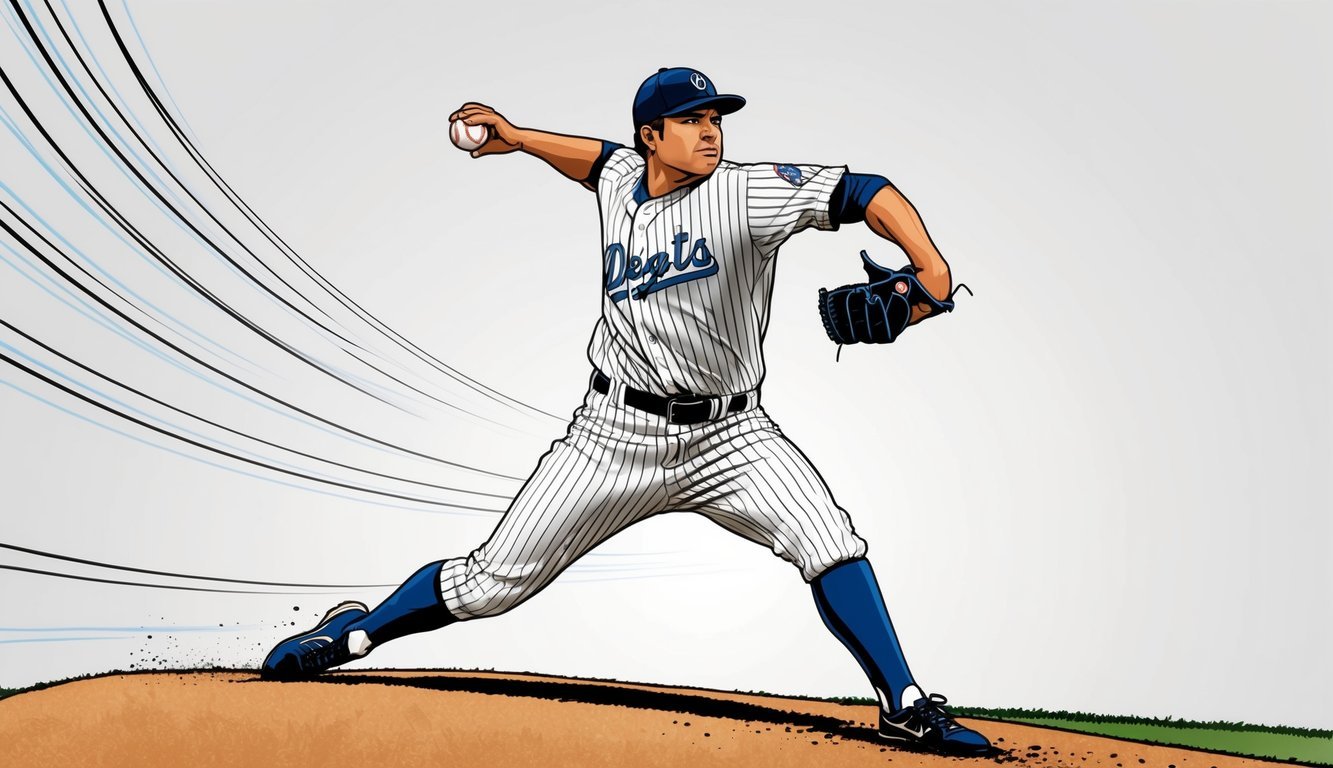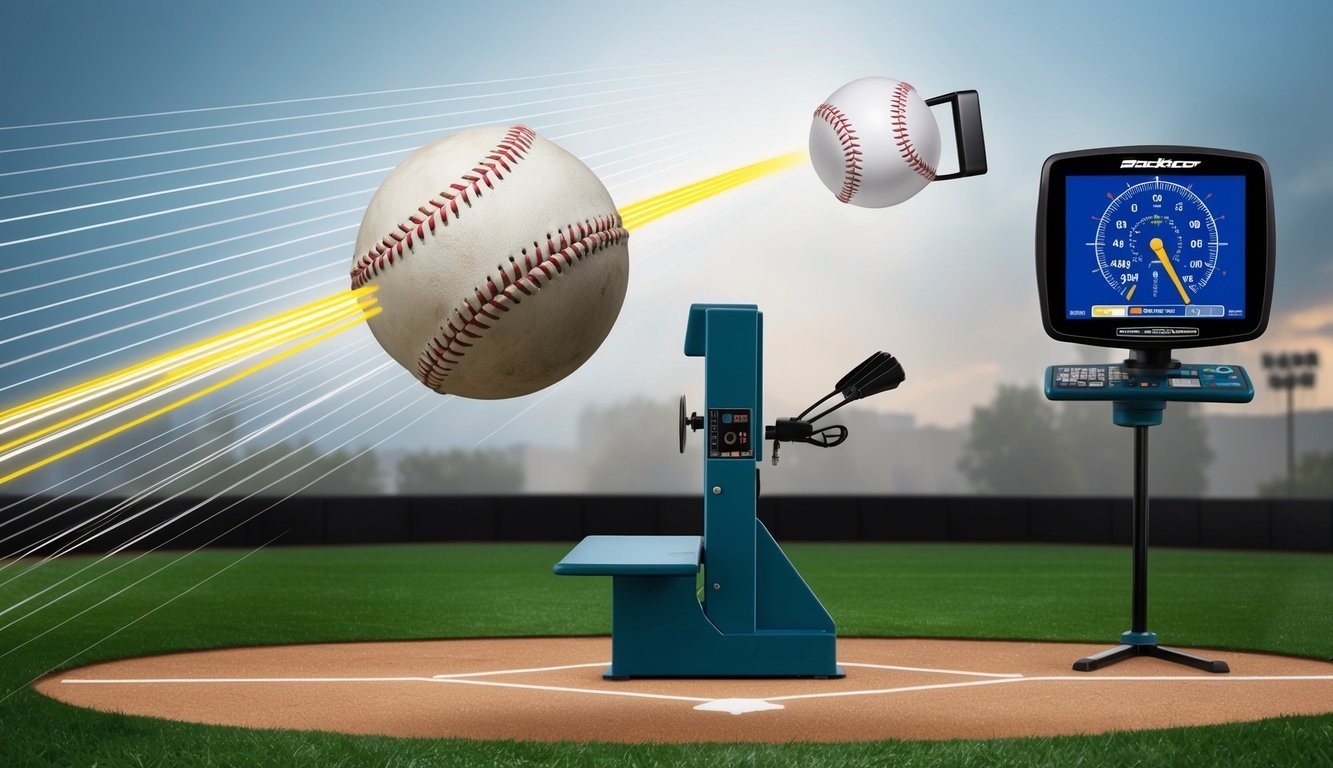Many baseball players want to pitch faster to improve their game.
Increasing velocity can give pitchers a significant advantage on the mound, making their pitches more challenging for batters to hit.
Players need to focus on improving their mechanics, building strength, and enhancing their overall athleticism to pitch faster.
Developing a faster fastball requires a combination of proper technique and physical conditioning.
Pitchers must work on their grip, arm action, and lower body mechanics to generate more power and speed.
Strengthening exercises targeting the core, legs, and throwing arm can also contribute to increased velocity.
Consistent practice and dedication are key to seeing improvements in pitching speed.
Incorporating specialized drills and using tools like weighted balls can help pitchers gradually build up their velocity over time.
With the right approach and commitment, many players can add several miles per hour to their fastball, giving them a competitive edge on the diamond.
Foundations of Pitching Velocity
Pitching velocity stems from a complex interplay of physical and mechanical factors.
The kinetic chain and lower body mechanics form the essential groundwork for generating power and speed in a pitcher’s throw.
Understanding the Kinetic Chain
The kinetic chain in pitching refers to the sequence of movements that transfer energy from the ground up through the body to the ball.
It starts with the legs, moves through the hips and trunk, and finishes with the arm and hand.
Proper sequencing is crucial for maximizing velocity.
Efficient energy transfer relies on timing and coordination.
Pitchers should focus on:
- Leg drive
- Hip rotation
- Core engagement
- Shoulder rotation
- Arm acceleration
Strengthening each link in the chain can lead to increased pitching velocity.
Exercises targeting the legs, core, and upper body help build the necessary power for faster pitches.
Essential Role of Lower Body Mechanics
Lower body mechanics play a pivotal role in generating pitching velocity.
Strong, explosive legs provide the initial thrust that propels the entire pitching motion.
Key aspects of lower body mechanics include:
- Stride length and direction
- Hip mobility and rotation
- Knee flexion and extension
- Ankle stability
Pitchers with solid lower body mechanics can generate more force from the ground up.
This translates to higher velocities, often reaching 90+ mph in Major League Baseball.
Exercises to improve lower body strength and power:
- Squats
- Lunges
- Box jumps
- Hip mobility drills
Developing these foundational elements can help pitchers unlock their velocity potential and reach new levels of performance on the mound.
Strength and Conditioning
Building a solid foundation of strength and conditioning is crucial for pitchers looking to increase their throwing velocity.
A well-rounded program targets key muscle groups and improves overall athletic performance.
Core Strength for Stability and Power
A strong core is essential for generating power and maintaining stability during the pitching motion.
Incorporate exercises like planks, Russian twists, and medicine ball rotations into your routine.
Aim for 3 sets of 15-20 reps for each exercise, 2-3 times per week.
Don’t forget to include lower back strengthening exercises like supermans and bird dogs to balance out your core training.
For an added challenge, try using resistance bands during your core workouts.
This can help increase tension and build explosive power.
Customizing Your Workout Routine
Tailor your strength training to address your specific needs as a pitcher.
Focus on exercises that target the entire kinetic chain, from your legs to your throwing arm.
Include compound movements like squats and lunges to build lower body strength.
These exercises help create a stable base and generate more power from the ground up.
For upper body strength, incorporate exercises like push-ups, pull-ups, and shoulder presses.
Use a mix of bodyweight exercises and resistance training with weights or bands.
Remember to balance pushing and pulling movements to maintain shoulder health.
Aim for 2-3 full-body strength sessions per week, allowing for adequate rest between workouts.
Start with lighter weights and focus on proper form before gradually increasing the load.
Pitching Mechanics and Techniques

Mastering proper pitching mechanics is crucial for increasing velocity and improving control.
A pitcher’s technique involves a complex sequence of movements that, when executed correctly, can lead to faster, more accurate pitches.
Refining Your Pitching Motion
The pitching motion starts with a balanced stance on the mound.
As the pitcher begins their wind-up, they shift their weight to the back leg.
The stride length is important – too short reduces power, while too long can throw off balance.
A good rule of thumb is about 80-90% of the pitcher’s height.
During the delivery, the pitcher’s body should move in a straight line towards home plate.
The arm action should be smooth and efficient, with the elbow leading the way.
At the release point, the pitcher’s body should be in a strong, balanced position with the chest facing the target.
The follow-through is equally important.
It helps decelerate the arm safely and can improve accuracy.
Pitchers should finish with their throwing arm coming across their body and their back leg coming forward.
Mastering Grip and Release
The grip is a key factor in pitch velocity and movement.
For a fastball, pitchers typically use a four-seam grip, placing their index and middle fingers across the horseshoe seams.
This grip allows for maximum backspin and velocity.
The release point is crucial for both speed and control.
Pitchers should focus on releasing the ball out in front of their body, with their arm fully extended.
This allows for maximum leverage and velocity.
Consistency in release point across different pitches is vital for maintaining control and keeping batters guessing.
Pitchers can practice this by using targets during bullpen sessions and focusing on repeating their mechanics with each throw.
Enhancing Mental and Physical Agility

Pitching faster requires a combination of physical flexibility and mental sharpness.
Developing both aspects can significantly improve a pitcher’s performance on the mound.
Importance of Flexibility and Mobility
Flexibility and mobility play crucial roles in a pitcher’s ability to generate speed and power.
Regular stretching routines, including dynamic warm-ups before games, help prevent injuries and increase range of motion.
Yoga can be particularly beneficial, improving balance and core strength.
Foam rolling is another effective technique for enhancing mobility.
It helps release muscle tension and improves blood flow.
Pitchers should focus on rolling out their shoulders, back, and legs.
Incorporating agility drills into training sessions can boost overall athleticism.
Quick feet exercises and lateral movements improve a pitcher’s ability to field their position effectively.
These movements help pitchers react swiftly to bunts and comebackers, enhancing their defensive skills.
Integrating effective baseball coaching drills that focus on foot speed and coordination ensures that players develop the agility needed for game situations.
Consistent practice with these drills can lead to quicker reflexes and better overall performance on the field.
Psychological Focus and Consistency
Mental preparation is just as important as physical training for pitchers aiming to increase their velocity.
Visualization techniques can help pitchers mentally rehearse their perfect pitch, building confidence and muscle memory.
Developing a pre-game routine helps establish consistency and focus.
This might include listening to music, deep breathing exercises, or reviewing game strategies.
Maintaining a positive mindset is key.
Pitchers should practice positive self-talk and avoid dwelling on mistakes.
Instead, they should focus on the next pitch and trust their abilities.
Building mental toughness through challenging practice scenarios can help pitchers stay composed under pressure during games.
This mental resilience often translates to improved performance and faster pitches.
Practical Drills and Increasing Speed

Boosting pitching velocity requires a combination of targeted drills and specialized equipment.
Proper technique and consistent practice are key to throwing faster pitches on the mound.
Utilizing Training Aids and Equipment
Weighted balls are popular for increasing arm strength and pitch speed.
Pitchers can gradually increase ball weight during training sessions.
Start with 20-30 throws using a slightly heavier ball, then switch back to regulation baseballs.
Resistance bands help develop arm and shoulder muscles crucial for pitching.
Attach bands to a fence and practice throwing motions to build strength throughout the pitching motion.
Radar guns provide instant feedback on pitch speed.
Set speed goals and track progress over time.
Many portable models are now affordable for individual use.
Pitching Drills to Boost Velocity
The towel drill improves arm speed and mechanics.
Snap a towel towards a target, focusing on quick arm action and proper follow-through.
Repeat 15-20 times per session.
Long toss builds arm strength and extends throwing distance.
Start at 60 feet and gradually increase to 300 feet or more.
Maintain proper mechanics throughout.
The rocker drill enhances lower body power.
Start in the stretch position, rock back and forth, then explode towards home plate.
Focus on driving off the back leg.
Plyometric exercises like medicine ball throws develop explosive power.
Perform rotational throws against a wall, simulating the pitching motion.
Do 3 sets of 10 reps.
Recovery and Injury Prevention

Pitchers must prioritize their physical well-being to maintain performance and longevity in baseball.
A balanced approach to recovery and injury prevention is crucial for success on the mound.
Establishing a Healthy Routine
Pitchers should develop a consistent routine that includes proper warm-ups and cool-downs.
Before throwing, dynamic stretches help prepare muscles and joints for activity.
A thorough warm-up might include:
- Light jogging
- Arm circles
- Shoulder rotations
- Leg swings
Post-pitching, static stretches and gentle exercises can aid in reducing muscle tension.
Ice therapy for 15-20 minutes after throwing sessions can help minimize inflammation.
Proper hydration and nutrition are vital.
Pitchers should drink water throughout the day and consume balanced meals rich in lean proteins, complex carbohydrates, and healthy fats.
Understanding the Importance of Rest and Recovery
A pitcher’s arm health and performance benefit from adequate rest.
Overuse can lead to fatigue and increased injury risk.
Rest days should be incorporated into training schedules.
During these periods, pitchers can focus on light cardio exercises, core strengthening, and lower body workouts.
Sleep plays a critical role in recovery.
Pitchers should aim for 7-9 hours of quality sleep each night.
This helps repair muscle tissue and maintain cognitive function.
Active recovery techniques like swimming or yoga can promote blood flow without straining the arm.
These activities help maintain flexibility and reduce muscle soreness.
